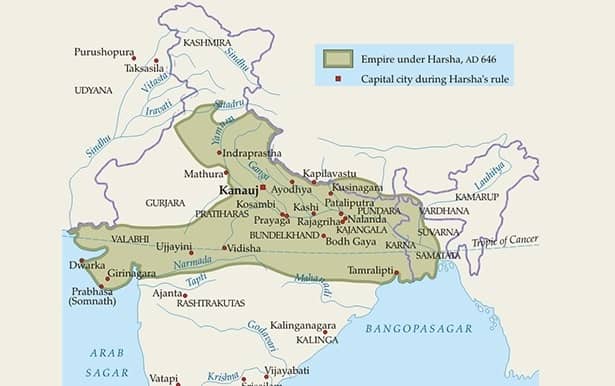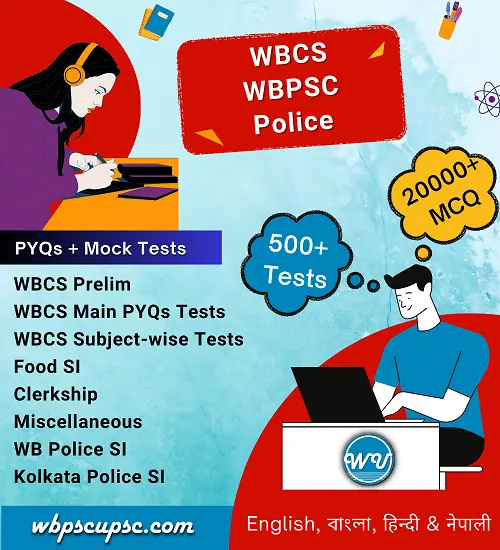March 7, 2019
Pushyabhuti Dynasty – Harshavardhan
Contents
>>>>>>>
Pushyabhuti Dynasty
- The decline of the Gupta Empire had, resulted in the splitting of northern India into several kingdoms.
- Most important of those was Pushyabhuti dynasty.
- Harshavardhan was the most important ruler of Pushyabhuti dynasty.
- They were feudatory of the Guptas and were known as Vardhans.
- Their capital was at Thanesar (near Kurukshetra, Haryana).
- Major historical sources of information regarding the Pushyabhuti dynasty
- Harshacharita – biography of king Harshavardhan written by Banabhatta.
- Si Yu Ki – written by Chinese pilgrim Hsuan Tsang / Xuanzang.
>>>>>>>
>>>>>>>
Prabhakar Vardhana
- Prabhakar Vardhana established marital alliances with the Maukharis of Kannauj
- He married Rajyashri, daughter of the Maukhari ruler Grahavarman.
- After the death of Prabhakar Vardhana, his elder son Rajya Vardhana came to the throne.
>>>>>>>
Harshavardhan (606 – 647)
- Rajyavardhana left the reigns of governance in the hands of Harshavardhan and went for a campaign against the ruler of Malwa, Devagupta and Shashanka, the ruler of Gauda.
- Shashanka had imprisoned their sister Rajyashri and killed her husband Grahavarman.
- Rajyavardhana defeated the Malwa army and killed Devagupta.
- But he was unfortunately killed by Shashanka.
- Harshavardhan succeeded Rajyavardhana after his death, at the age of 16.
- He forged an alliance with Bhaskaravarman, the Kamarupa king and marched towards Kannauj and rescued his sister Rajyashri.
- Kannauj subsequently came under the sovereignty of Pushyabhutis.
- Later, Harshavardhan also defeated Shashanka and extended his control over parts of Kongoda in Orissa.
- He is known as the last great Hindu king of India.
- Harshavardhan was originally a Shaiva but also supported Buddhism.
- It is believed that Hiuen Tsang converted him to Mahayana Buddhism.
- Harshavardhan prohibited animal slaughter for food in his kingdom.
- He was also described as lord of the north (sakalauttarapathanatha).
- Banabhatta was his court poet.
- Banabhatta wrote Harshacharita and one of the world’s earliest novels, Kadambari.
>>>>>>>
Kannauj Assembly
- It was presided over by Hiuen Tsang.
- 20 kings, 1000 scholars of Nalanda University, 3000 Brahmins and Jains attended this assembly at Kannauj.
- Hiuen Tsang explained and established superiority of values of Mahayana doctrine over others.
- However, violence broke out and an assassination attempt was made on Harshavardhan’s life.
>>>>>>>
Allahabad Assembly (Prayag Assembly)
- It was held for 75 days, where quinquennial distribution by the king to the people happened.
- Hiuen Tsang was invited by king Harshavardhan at Prayag.
- Hiuen Tsang writes that Harsha actually gave away everything from the royal treasury.
>>>>>>>
>>>>>>>
Gauda Kingdom
Shashanka (590 – 625)
- King Shashanka created the first separate political entity in the Bengal
- His capital was at Karnasubarna, present day Murshidabad in West Bengal.
- The development of the Bengali calendar is often attributed to Shashanka
- Prior to Shashanka, Bengal was divided into three regions, Banga, Samatata and Gauda.
- Shashanka rose to power taking the advantage of the weak ruler.
- After death of Mahasenagupta, Shashanka drove the later Guptas and other prominent nobles.
- He was succeeded by his son, Manava.
- However, Gauda kingdom was soon divided amongst Harsha and Bhaskaravarman of Kamarupa.
>>>>>>>
>>>>>>>
Huan Tsang Account
- Book – Si Yu Ki
- Biography – Hui Li
- According to Huan Tsang, dowry & Sati system was prevalent in Indian society with no system of widow remarriage.
- Sudras were known as agriculturist.
- Trade declined & less issuance of coins because of political and economic uncertainty.
- Grants of land gained popularity.
- Thieves at state were met with extreme punishments.
- The first written evidence of the Kumbha Mela can be found in Huan Tsang book.
>>>>>>


